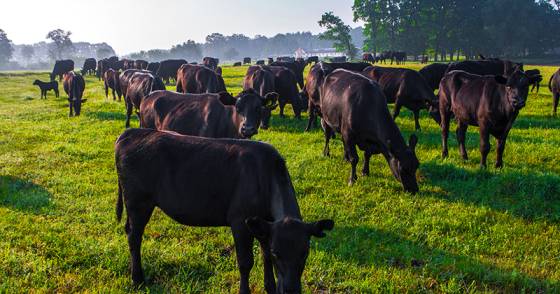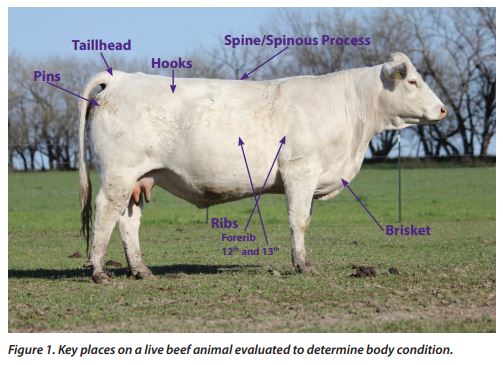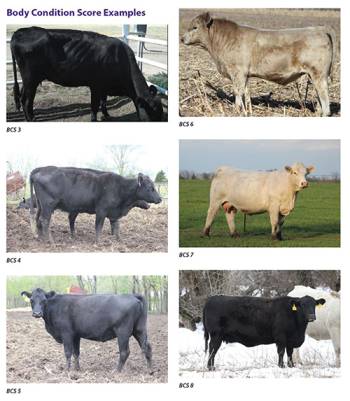Cattle Body Conditions Scoring
Aug 21, 2020
Megan Hasenour | Marketing Communications Manager

Body condition scoring is a powerful technique utilized to estimate cattle body fat and nutritional status of your cattle. This can be done by using visual indicators of the key bone structure for fat cover. The key areas for evaluation are the backbone, ribs, hips, pinbones, tailhead and brisket. Measurement is the first step in successful herd management and plays a pivotal role in maximizing fertility in your breeding herd. The greatest influence for rebreeding is a beef cows body condition at calving, especially for spring-calving heifers/cows.

Late summer to Early fall is a good time to perform body condition scoring on your beef cows. Before you can begin to use body condition scores successfully, you need to recognize how different body fat levels look while your cattle are out on the pasture.
If body condition scoring is new to you, just focus on separating cows into groups of:
Body condition scores are simply a way of visually estimating different levels of body fat. Most producers use either a 9-point or 5-point scale to categorize cattle from thin to obese.
Here is an example of the 9-point Body Condition Scoring for Beef Cow Herd from the University of Nebraska:
Thin Body Condition
1) Bone structure of shoulder, ribs, back, hooks and pins are sharp to the touch and easily visible. No evidence of fat deposits or muscling. Cattle in this condition are weak, near death and have trouble standing or walking.
2) No evidence of fat deposition and muscle loss in the hindquarters. The spinous processes feel sharp to the touch. The spinous processes and the spaces between them are easily seen.
3) Very little fat cover over the loin, back and fore-ribs. The backbone is still highly visible. Processes of the spine can be identified individually by touch and ma still be visible. Spaces between the processes are less pronounced.
Moderate Body Condition
4) Fore-ribs and 12th and 13th ribs are still noticeable to the eye. The transverse spinous processes can be identified only by palpation (with slight pressure) and feel rounded rather than sharp.
5) The 12th and 13th ribs are slightly visible to the eye. The transverse spinous processes can only be felt with firm pressure and feel rounded but are not noticeable to the eye. Spaces between the processes are not visible and are only distinguishable with firm pressure. Areas on each side of the tailhead and the fore-rib, behind the shoulder are starting to fill.
Fleshy Body Condition
6) Ribs are fully covered and are not noticeable to the eye. Hindquarters are plump and full. Noticeable springiness over the fore-ribs and on each side of the tailhead. Firm pressure is now required to feel the transverse processes. Brisket has some fat.
7) Ends of the spinous processes can only be felt with very firm pressure. Spaces between processes can barely be distinguished. Abundant fat cover on either side of the tailhead with evident patchiness. Fat in the brisket.
8) Animal takes on a smooth, blocky appearance. Bone structure disappears from sight. Fat cover is thick and spongy and patchiness is likely. Brisket is full.
9) Bone structure is not seen or easily felt. The tailhead is buried in fat. The animal's mobility may actually be impaired by excessive fat.

Ideally, cows should have a body condition score of 5 to 6, and first calf heifers should have a body condition score of 6 at calving time to support the calf.
A cow with poor nutrition or body score might take longer to breed back and the longer she stays open, the more money you’re losing on her. If a low body condition cow does rebreed, she could have trouble calving or supporting the calf’s health.
It’s important to remember that body condition scoring is subjective and the way you score your cattle could be different than how your neighbor scores theirs. The important thing is that you are consistent on how you score your herd.
For nutrition recommendations for your herd, our Livestock Nutrition Team would be happy to help you build a solid nutritional program to help improve their health and BCS.

Body condition scoring is a powerful technique utilized to estimate cattle body fat and nutritional status of your cattle. This can be done by using visual indicators of the key bone structure for fat cover. The key areas for evaluation are the backbone, ribs, hips, pinbones, tailhead and brisket. Measurement is the first step in successful herd management and plays a pivotal role in maximizing fertility in your breeding herd. The greatest influence for rebreeding is a beef cows body condition at calving, especially for spring-calving heifers/cows.

Late summer to Early fall is a good time to perform body condition scoring on your beef cows. Before you can begin to use body condition scores successfully, you need to recognize how different body fat levels look while your cattle are out on the pasture.
If body condition scoring is new to you, just focus on separating cows into groups of:
- Thin
- Moderate
- Fat
Body condition scores are simply a way of visually estimating different levels of body fat. Most producers use either a 9-point or 5-point scale to categorize cattle from thin to obese.
Here is an example of the 9-point Body Condition Scoring for Beef Cow Herd from the University of Nebraska:
Thin Body Condition
1) Bone structure of shoulder, ribs, back, hooks and pins are sharp to the touch and easily visible. No evidence of fat deposits or muscling. Cattle in this condition are weak, near death and have trouble standing or walking.
2) No evidence of fat deposition and muscle loss in the hindquarters. The spinous processes feel sharp to the touch. The spinous processes and the spaces between them are easily seen.
3) Very little fat cover over the loin, back and fore-ribs. The backbone is still highly visible. Processes of the spine can be identified individually by touch and ma still be visible. Spaces between the processes are less pronounced.
Moderate Body Condition
4) Fore-ribs and 12th and 13th ribs are still noticeable to the eye. The transverse spinous processes can be identified only by palpation (with slight pressure) and feel rounded rather than sharp.
5) The 12th and 13th ribs are slightly visible to the eye. The transverse spinous processes can only be felt with firm pressure and feel rounded but are not noticeable to the eye. Spaces between the processes are not visible and are only distinguishable with firm pressure. Areas on each side of the tailhead and the fore-rib, behind the shoulder are starting to fill.
Fleshy Body Condition
6) Ribs are fully covered and are not noticeable to the eye. Hindquarters are plump and full. Noticeable springiness over the fore-ribs and on each side of the tailhead. Firm pressure is now required to feel the transverse processes. Brisket has some fat.
7) Ends of the spinous processes can only be felt with very firm pressure. Spaces between processes can barely be distinguished. Abundant fat cover on either side of the tailhead with evident patchiness. Fat in the brisket.
8) Animal takes on a smooth, blocky appearance. Bone structure disappears from sight. Fat cover is thick and spongy and patchiness is likely. Brisket is full.
9) Bone structure is not seen or easily felt. The tailhead is buried in fat. The animal's mobility may actually be impaired by excessive fat.

Ideally, cows should have a body condition score of 5 to 6, and first calf heifers should have a body condition score of 6 at calving time to support the calf.
A cow with poor nutrition or body score might take longer to breed back and the longer she stays open, the more money you’re losing on her. If a low body condition cow does rebreed, she could have trouble calving or supporting the calf’s health.
It’s important to remember that body condition scoring is subjective and the way you score your cattle could be different than how your neighbor scores theirs. The important thing is that you are consistent on how you score your herd.
For nutrition recommendations for your herd, our Livestock Nutrition Team would be happy to help you build a solid nutritional program to help improve their health and BCS.